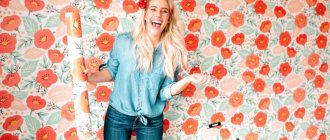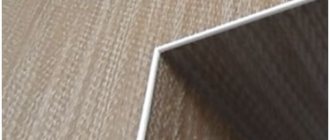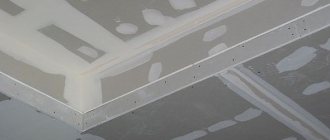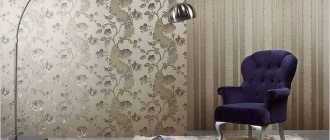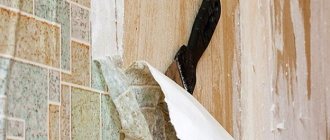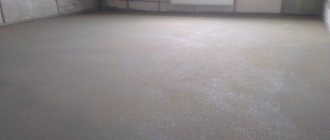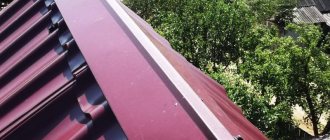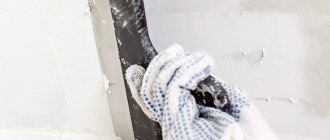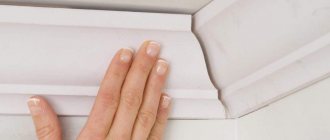Scope of application of fiberglass, its advantages and disadvantages
Fiberglass: description of material
Fiberglass is a fabric made from special glass fibers, onto which impregnation from modified starch is applied. They are based on glass, which, as a result of melting under the influence of high temperatures, forms the finest threads, layered on top of each other in a chaotic manner. The threads are used to make complex weaves - “cobwebs”, which give the material its second name. Next, the fiberglass is subjected to strong pressure, which gives it increased strength.
Where is it used?
Cobwebs are widely used in production related to the production of polyvinyl chloride panels for finishing walls and ceilings, and polymer materials for roofing. Cloths protect pipelines from corrosion during the installation of drainage systems.
And yet, fiberglass finds its main use in finishing work. It is used to reinforce the surface of drywall before applying the finishing layer of putty mixture. The web perfectly levels the bases and eliminates small flaws. Using fiberglass, they solve the problem of cracks on ceiling and wall surfaces.
Fiberglass is also used before wallpapering the ceiling for better adhesion of the material to the base coat.
Advantages and disadvantages
Cobwebs are currently widely used in repairs and remodeling, due to the large number of advantages that this material has:
- not electrified;
- hypoallergenic;
- not deformed. Gluing fiberglass to the ceiling will prevent cracks and chips from appearing;
- fire resistant;
- moisture resistant;
- levels and strengthens any surfaces of ceilings and walls;
- wear-resistant;
- can withstand up to 5 dyeing cycles;
- not afraid of temperature changes and humidity;
- protects surfaces from mold, allows air to pass through well;
- does not pose a health hazard;
- in the process of gluing fiberglass, foamed polystyrene is sometimes used. Thus, additional insulation of the room is carried out.
However, the material has one significant drawback. To work with glass wallpaper, you need to purchase appropriate clothing, since when cutting the canvas or during the process of gluing it, small particles may fall off the web and get into the eyes or respiratory tract.
How to choose fiberglass?
To purchase high-quality material that will meet all the characteristics mentioned above, you need to choose products from well-known manufacturers.
It is best to purchase high-quality fiberglass “spider web” from famous world brands
In the Russian building materials market, products from manufacturers from Holland – “Spektrum”, Finland – “Wellton”, and Sweden – “Oscar” and “Samtex” have gained popularity. Of the domestic manufacturers, the technology for manufacturing fiberglass, in full compliance with international standards, has been well mastered. It should be noted that almost all companies producing fiberglass, in addition to them, produce fiberglass wallpaper, as well as adhesive compositions for them - these products are sold under the general brand of the company. It is advisable to use canvas and glue of the same brand - they are completely adapted to each other.
In conclusion, I would like to remind you that painting fiberglass “gossamer” is primarily intended for reinforcing the walls and ceilings of rooms and protecting them from the expansion of small cracks that have appeared, as well as from the appearance of new ones. The second function that this material is designed to perform is leveling surfaces. However, many homeowners also prefer to preserve the structure of fiberglass, without covering it with putty, and using it as a decorative material. Thus, the “web” acquired a third function.
One cannot but agree that this multifunctional material helps solve many problems and save money allocated for interior decoration. Therefore, for many owners it can become a real salvation when carrying out any repairs - both cosmetic and major.
And at the end of the publication, traditionally, there is a video on the topic. This time, a professional finisher will share his experience of gluing fiberglass “cobwebs”.
Manufacturers
Fiberglass for ceilings is produced by different manufacturers in rolls 1 m wide. The most popular are the following:
- Wellton is a company from Finland. The glass fiber produced by it tolerates staining well;
- Oskar is a company from Russia that produces durable and affordable materials;
- Nortex is a manufacturer from China. Its products attract with low prices and good quality;
- Spectrum is a brand from Holland.
As for the cost, the price of cobweb depends on its density. The cheapest materials are offered by China - 600 rubles per roll with a density of 50 g/m², the most expensive - Wellton (1065 rubles per roll of web with a density of 45 g/m²).
All materials produced by the above brands are produced using standard technology, so their properties are almost identical to each other. Whom to give preference is up to you to decide.
Why do you need fiberglass?
Fiberglass, one of the varieties of materials for puttying or painting. It is a thin non-woven sheet that is pressed from fiberglass threads. It looks like a grid. This material is manufactured in rolls, one meter wide and twenty and fifty meters long. It should be borne in mind that this material is not intended for finishing. Its area of application is to protect surfaces from cracks.
The web has a density from 20 g/m2 to 60 g/m2. For painting, a mesh of lower density is used, for reinforcement of a higher density. This material allows you to hide microcracks and also allows the walls to breathe. The complete naturalness of the material does not disturb the environmental conditions of the room. When used, the appearance of fungus is prevented; it does not react with chemicals. Can be used in areas with high humidity.
Fiberglass web adds increased strength to the base and prevents cracks
Use to strengthen the ceiling
Fiberglass is used as a reinforcing element when additional strengthening of surfaces is necessary.
The fiberglass sticker on the ceiling is carried out in the following order:
- remove the old finish, level, putty and prime the ceiling;
- measure and cut pieces of suitable size from the canvas, leaving a small margin;
- fiberglass is glued to the ceiling end-to-end or at a short distance of the elements from each other;
- smooth the material from the center to the edges with a plastic spatula;
- After the entire surface of the ceiling is covered with cobwebs, its excess edges along the walls are carefully trimmed with a stationery knife.
After 24 hours, the surface will be completely dry, and you can proceed to further finishing.
Glue for fiberglass
There is a special glue for fiberglass, it says “for glass wallpaper”. Yes, because canvas is a special case of glass wallpaper. Every normal manufacturer has this type of glue, it differs from ordinary wallpaper glue by special additives - methylcellulose, sometimes PVA, so it is more powerful than standard starch. Sold both in the usual cardboard packs and in buckets in finished form. Among dry adhesives, our craftsmen like Quelyd, Krass, and Pufas the most. Among the ready ones is Oscar. You all probably know how to prepare glue - pour it very slowly into a bucket of cold water with constant stirring. Lumps and dirt should not be allowed. As for consumption, it will be much higher than the numbers written on the pack. On average, one pack per half kilo is enough for 20-25 squares, which is due to the peculiarities of the technology. We will talk about them.
Application for decorative finishing
Fiberglass can be painted or coated with other materials only after it has completely dried. If the paint is applied directly to the fiberglass, the web structure will show through the finish. But this technique will give the surface an original look.
To obtain a perfectly flat base, you will need to first level the fiberglass with a layer of putty.
Typically, dry mixtures are used for work, which are stirred in water until the desired consistency is obtained. Apply the composition in a thin layer, not exceeding 1.5-2 mm, using a spatula.
Next, the surface is grouted, but before that you need to make sure that the material is completely dry. The work is carried out with a special grater or grinding machine, where abrasive paper is attached.
Important! If two or more layers of putty are to be applied, each layer must dry well. Moreover, the next layer must be applied to the surface no earlier than 12 hours after applying the previous one.
Painting fiberglass web application: how to paint
If you decide to paint the canvas, then we recommend using water-based paint for such a surface. Such paint will retain the properties of the finishing material itself and, moreover, more than one layer of paint can be laid on it in an even layer.
Using painting fiberglass, how to paint correctly video
For painting you will need the following tools:
- a tray where the paint will be poured;
- a roller, preferably with a thread-type pile (you can use a paint brush, but then the painting process will take a long time).
It is necessary to paint the fiberglass spider web twice, that is, apply two layers of paint. It is worth noting that the time between applying layers should be at least 12 hours. To roll a seam, you need to use a “wing”; if you do it with a roller, the result will not be optimal. In principle, these are all the features of painting such a finishing material.
Fiberglass for plasterboard ceiling
The web can also be used to strengthen plasterboard ceiling structures. Experts recommend using it regardless of whether the joints between the sheets were treated with serpyanka or not. It will protect the plasterboard from losing its original shape if the material was stored incorrectly. Pasting plasterboard with cobwebs is carried out according to the standard principle. The only point is that the surface requires preliminary preparation for reinforcement.
Additional materials for finishing the ceiling with plasterboard.
Before the fiberglass is glued to the ceiling, you will need to seal the seams between adjacent sheets, as well as the recesses from the screws, with several layers of putty. After this, the entire ceiling area is covered with adhesive. It will become an alternative to primer and will prevent the absorption of the new layer of composition on which the glass wallpaper will be attached.
Important! Before applying the next layer of glue, you must wait until the previous one has completely dried.
Paint for fiberglass
How to paint fiberglass correctly? Experts recommend choosing water-dispersion paints, as they have the following advantages:
- Absolutely harmless to the human body.
- They are odorless as they are based on water and polymers.
- Can be used in any room.
- They do not change the properties of the canvas.
- Layers of paint lie smoothly, regardless of their number.
Most often, the following types of water-dispersion paints are used for painting fiberglass:
- Acrylic. Such paints are most popular because they have the following characteristics:
- Dries quickly.
- They have excellent adhesion.
- They are not afraid of moisture.
- Availability in terms of price.
- Possibility of obtaining almost any shade.
- Latex. The performance properties of latex paints are higher than acrylic ones, but they are more expensive. Advantages of the material: moisture resistance, durability, increased wear resistance.
Important! Unlike acrylic coatings, latex coatings can form a glossy surface.
- Silicone. This type of paint is the most expensive. However, silicone paints include all the positive qualities of acrylic and latex compositions and do not have the disadvantages. In addition, this type of paint has dirt-repellent properties, which allows you to wash painted surfaces much less frequently.
How to stick fiberglass on ceilings
Preparation of the adhesive composition
To glue the web, you can use the most common wallpaper glue. However, experts still advise purchasing special compounds that provide better adhesion of the material to the surfaces to be finished. They can be sold dry and ready-made. Dry mixtures are diluted with water according to the instructions on the package.
You can also use certain types of putty as glue. However, this is not the best option, since the mixture will not completely saturate the fiberglass; voids will form between the web and the putty layer, which will lead to the material falling off.
Some argue that the putty composition should be applied to a surface previously moistened with water. But this is also not a solution. This approach can ruin not only glass wallpaper, but also sheets of drywall.
How to glue fiberglass to ceilings for painting
Many people wonder how to properly glue fiberglass to the ceiling. You can choose one of two ways:
- without joints;
- with joints.
Make your choice based on what kind of light prevails in your room - natural sunlight or artificial light from devices. Since the visibility of the seams on the ceiling depends on this factor.
The process of gluing drywall with cobwebs involves the following sequence of actions:
- the surface needs to be primed and wait for it to dry completely;
- prepare the adhesive composition;
- spread fiberglass on the floor, cut into pieces of the required size;
- Apply glue to drywall and cobwebs with a roller;
- wait until the material is saturated with glue.
Next we proceed depending on the chosen method. Pasting without joints is more often used. To do this, the web is applied to the ceiling, leaving small gaps of 2-3 mm between the individual elements. Subsequently, the cracks will be filled with putty, the surface will be smooth and even.
The second method involves joining the glued pieces or slightly overlapping the next element onto the previous one. With this approach, the seams will be noticeable.
Important! During the pasting process, it is necessary to maintain the air temperature in the room at least 10°C and no more than 25°C, while the windows must be tightly closed, and direct sunlight should not fall on the surfaces to be pasted.
After the entire surface is covered with glass wallpaper, you can proceed to painting it.
Painting fiberglass
Before painting, a new layer of primer is applied to the surface, which will improve the adhesion of the paint composition and reduce its consumption.
Coloring is carried out as follows:
- furniture, floors, window openings, doors are covered with plastic film to protect from contamination;
- mix the paint until smooth. If necessary, add color to the paint until the desired shade is obtained, pour it into a separate container;
- the roller is dipped into the composition, lightly squeezed, and the ceiling is painted in one direction in an even layer;
- after the first layer has dried well, the procedure is repeated, but in the opposite direction;
- at the last stage, hard-to-reach areas are tinted.
After painting and complete drying of the surface, the ceiling can be used.
Glue consumption per 1m2
The question of glue consumption when finishing walls or ceilings with fiberglass paints arises quite often, because such a process will require a lot of it. The fact is that there are no standards in this regard. It is impossible to accurately calculate the amount of glue that will be used per square meter of surface, because it will depend on who will apply this glue to the surface.
If there is little glue, you will see it yourself; if there is too much glue, it will also be difficult not to notice. In order to sufficiently saturate the surface with glue, you must monitor the color of the fiberglass web; as soon as it darkens from moisture, there is a sufficient amount of glue on its surface.
- After we have glued the second sheet with an overlap, we saturate it with a layer of glue and, without fail, press it well against the wall. In order for the seams between the sheets to be invisible, you need to cut a strip through both glued layers, even if your cut turns out to be uneven, there is nothing wrong with that, we strive to ensure that the surface is smooth, and these unevenness of the strip you cut will not be visible on wall or ceiling.
- After 24 hours, the glue on the surface will dry completely, and you can proceed to the next stage of finishing.
Care instructions
Surfaces covered with fiberglass material do not require special care. The web is not electrified, so the finish is resistant to dust and other contaminants. For regular cleaning, you can wipe the coating with a damp cloth without using aggressive detergents. Dry cleaning with a vacuum cleaner is also allowed.
Canvases made from glass threads are primarily intended for reinforcing wall and ceiling surfaces and protecting coatings from cracks. But this is not the only function they perform. Another feature is the leveling of surfaces. Also, many people prefer to leave the structure of the web in its original form and not cover it with putty, but use it as a decorative element.
The large number of different functions that fiberglass performs makes it a real find for those who decide to renovate their home. It not only solves many problems associated with finishing, but also saves money.
Video material
Painting fiberglass and choosing the material for this process is no different from finishing glass wallpaper. The only difference is puttying, which allows you to eliminate all surface defects and make it perfect. Use our advice and recommendations from experts, and then the procedure for finishing the cobwebs will not be anything complicated!
Advantages and disadvantages of spider webs for painting
Fiberglass for wallpaper or painting is characterized by increased resistance to temperature changes. Substrate preparation can be carried out at temperatures from -40 to +60 °C, which will not affect the quality of the surface. The material is breathable and hygienic. Fiberglass does not attract or accumulate dust due to its antistatic properties. It eliminates the possibility of condensation forming on the surface, which is the cause of mold and mildew.
Gossamer fiberglass is characterized by hypoallergenicity, which is especially valuable for young children and people with allergies. They do not have a negative impact on human health, which is due to their environmental friendliness.
One of the significant advantages of the material is its fire resistance. It is impossible not to highlight the high wear-resistant qualities, due to which the base will retain its original appearance for a long time, which eliminates the need for frequent repairs. This surface can be painted several times. Fiberglass has an affordable price, as a result of which repairs can be performed efficiently and inexpensively.
Despite the large number of positive factors, fiberglass has quite serious disadvantages. It is necessary to work with the material with extreme caution, since small fragments of glass may break off when laying it. This can cause harm to health.
Cobwebs for painting are characterized by hypoallergenicity and resistance to temperature changes.
When glass fragments come into contact with the skin, they cause skin itching. A more serious consequence that will require seeing a doctor is the elements getting into the respiratory and visual organs. Therefore, it is necessary to work in closed clothing, gloves, a respirator and safety glasses.
Material advantages
Despite the fact that fiberglass, or as it is also known in the construction industry, “gossamer”, is similar to glass wallpaper in a number of characteristics, these materials have many differences. First of all, this concerns the manufacturing method. Unlike fiberglass wallpaper, fiberglass is not made on a machine, but by pressing, resulting in translucent sheets that resemble a “blotter”. The material, usually produced in 50-meter rolls, is smooth to the touch, although it may be a little itchy. Learn more about the types of rolled fiberglass.
The strength of the “web” is relatively small; careless handling can lead to its damage. However, the answer to the question of whether fiberglass is needed for painting is most often positive - due to the many advantages of using this material:
- After proper sticking to the surface, the “web” from a weak and fragile sheet turns into a reinforcing mesh that hides small imperfections in the wall or ceiling and prevents new cracks and defects from appearing.
- The material is practically resistant to exposure to liquids, fire, aggressive substances and abrasion.
- Fiberglass is not an allergen and does not accumulate static.
- “Gossamer” is easy to clean and allows water vapor to pass through during operation, providing optimal humidity in the room. It is also a completely environmentally friendly material that does not emit substances harmful to humans into the air.
In fact, the material has all the advantages of glass wallpaper. Although it is not intended for final finishing, but only for surface reinforcement. At the same time, canvas can be painted several times, unlike wallpaper.
What is fiberglass for painting?
The first step is to understand what fiberglass is. The material is represented by a non-woven fabric, which is obtained from the smallest glass fibers using pressing technology. Due to its appearance in the form of a translucent thin product, it is called a painting web. This can be seen in the photo of fiberglass for painting. The threads are connected to each other in a chaotic manner using an adhesive composition based on organic resins. The main raw material for the material is quartz sand.
Fiberglass can also be used in various construction and repair areas.
Fiberglass is sold in rolls 1 m wide and 50 m long. The density of the material can vary between 25-50 g/m², which is selected depending on the plane of application of the material. For vertical surfaces you need to take fiberglass of a lower density, and for walls you should use a denser material.
The main purpose of the material is to prepare the base for finishing. The use of fiberglass makes it possible to eliminate the formation of cracks on the surface. It allows you to level the base without the use of global and labor-intensive work, such as plastering the ceiling and walls.
Its main function is to reinforce the surface. A surface prepared in this way will retain its attractive, original appearance for many years, eliminating the need to mask any cracks that have arisen. The material is fixed using an adhesive mixture, followed by painting or wallpapering. Fiberglass can be used for different substrates in rooms of any purpose.
The material is characterized by its versatility and wide range of use in various fields of construction. It can be used when making drainage holes, for organizing waterproofing, making wall panels and floor cladding, preparing mastics when creating roofing, and to increase the service life of metal pipes.
Painting fiberglass is a non-woven fabric consisting of glass microfibers.
Methods of application
Glue the painting fiberglass onto smooth gypsum plaster or onto a layer of starting putty. According to the technology, after gluing, leveling is required with a thin layer of finishing putty (for stripping), then a primer, and then painting. With this sequence of work, paint consumption is minimal; for a good result, 2 layers of paint are enough. Despite the additional cost of putty, if you are using expensive paint, it is better to stick with this technique. This method is also used if the paint is glossy or semi-gloss.
There is another approach. The cobweb is glued and painted after drying. No puttying. The end result is a good result - a slightly structured surface with a slight “hairiness”. But it takes a lot of paint, and for a normal result you have to apply at least 4 layers. The first pass, the paint is absorbed very quickly, the consumption is 3-4 times more than normal. At the same time, the appearance of the wall is unsatisfactory: in some places there is not enough paint, in others - where we went over one place with a roller several times - there is a lot of it.
The second coat of paint takes almost half as much and looks a little better. Consumption continues to decrease, but not at the same rate. After 4 layers, the appearance of the wall is already normal, but the total amount of paint composition is impressive.
After gluing, it is advisable to cover the painting fiberglass with primer
To reduce paint consumption, after gluing, coat the painting fiberglass with a primer. Can be done in two layers. It will take a lot of primer, but much less paint. Moreover, even the first layer will lie well. For a good result, you will need 2-3 layers, but with normal consumption. So this method is also not bad, but it can be used with matte or semi-matte paint.
Fiberglass sticker
Before deciding whether it is possible to paint fiberglass and putty it before or not, the material needs to be glued to the wall. In this case, the surface to be glued needs to be prepared - leveled using putty, leaving cracks no more than 1 mm thick. You can refuse leveling only in cases where the wall is already quite smooth and strong.
Video:
The main nuances that arise during the preparatory work:
- wide cracks are sealed using a special compound for seams or regular putty, but in several steps;
- when using plasterboard sheets, the joints between them must be puttied and reinforced with self-adhesive fiberglass mesh (“serpyanka”); In order for the already pasted wall to be as smooth as possible, it is desirable that the seams between the drywall and the fiberglass sheets do not coincide with each other, otherwise cracks may appear in these places;
- dried “patches” on the wall need to be leveled using putty and sanded until the surface is almost perfectly flat;
- Before the fiberglass web for painting is glued to the wall, it should be cleaned of dust and thoroughly primed.
Due to the fact that the fiberglass gluing is done overlapping, when determining its area, you should take as the calculated value not only the surface of the walls, but also a small margin (at the level of 5–10%). And as an adhesive, it is advisable to use not ready-made, but dry glue, the characteristics of which are the same, and the price is much lower. During the work, special clothing is used - pants, long-sleeved shirts, gloves, a respirator and a hat. All this will help prevent fiberglass particles from getting on the skin and into the respiratory tract.
Other nuances that are taken into account when sticking include the correct laying of the canvas. Fiberglass sheets have a smoother front side - as a rule, it is located on the outside of the roll. It is she who should look inside the room, while the outside one should be applied to the wall or ceiling. You should also place the canvases so that the pile on them is directed in one direction. Otherwise, the paint applied to the material will have different shades.
The main stages of gluing fiberglass for painting are as follows:
- The roll is rolled out and cut into sheets of the required size, which is selected for the walls taking into account a slight overlap. For the ceiling, it is recommended to choose canvases up to 1.5 m long, which are easier to attach to a vertical surface.
- Glue (prepared according to instructions or ready-made) is applied in a thick layer to the surface, starting from the corner of the room. The width of the strip should be slightly larger than the size of the fiberglass itself, that is, about 1 m.
- The first sheet of canvas is glued close to the corner of the room, pressed with your hands and smoothed using a wallpaper spatula along the entire length from the middle of the canvas to the edges.
- The excess part of the fiberglass is trimmed with a knife along a ruler.
- The canvas, already glued to the surface, is coated with glue until the material is completely saturated. You can determine that the canvas has been completely coated by its color, which should become uniform by the end of the procedure.
The remaining sheets are laid in the same way, but with a slight overlap on the previous ones. After gluing and alignment, both panels are trimmed along the joint using a ruler. The cut parts are removed, and the resulting smooth seam is once again smeared with glue and pressed with a wallpaper spatula. When gluing corners, they try to get an even joint before cutting - the corner cloth tears more often than others, and a perfect cut will help avoid tears and cracks.
After the room has been completely covered with fiberglass, it is left closed until the glue dries completely. Usually this period lasts at least a day. At this time, drafts should not be allowed to appear in the room, otherwise air movement will lead to the material falling behind and the need for gluing it or even re-gluing it.
The procedure for gluing fiberglass
What fiberglass is glued to: other composition options
Glue in the form of a dry powder is more profitable to use. The finished composition can be prepared in the required volume. The powder should be diluted with warm water, which is carried out in accordance with the instructions. The dry composition can be bought for 400-450 rubles. for 0.5 kg.
On a note! According to reviews, it is better to paste fiberglass for painting with mixtures of recognized brands Wellton, Oskar, Pufas and Bostik.
Fiberglass can be glued using PVA glue. However, it should be borne in mind that the material has a low density, so it transmits a large amount of ultraviolet radiation. After some time, the glue will turn yellow, which will affect the decorative effect of the final coating. Therefore, when gluing fiberglass to PVA glue, paint should be chosen in dark shades.
Experts recommend using only special glue for fiberglass for gluing.
You can make glue yourself. Before gluing the canvas with gelatin, prepare a composition at the rate of 25 g of the substance per 350 ml of water. After the gelatin has been soaked for 1 hour, add ½ tablet of crushed aspirin and 1 tsp. glycerin or castor oil. The mixture is heated to a temperature of 40-45 °C and removed from the heat. When the glue cools, it will have the consistency of a medium soft jelly.
What to glue fiberglass on: choosing the right composition
For gluing to the surface of fiberglass, two types of glue can be used: dry powder and ready-made mixture. It is important to choose formulations designed specifically for this material. Wallpaper glue will not work. This is due to the fact that fiberglass is heavier than paper, so a regular composition may not withstand such weight. In addition, fiberglass fabric has a structure consisting of woven fibers that wallpaper glue will not connect.
The adhesive composition for fiberglass for painting on a ceiling or wall includes high-quality components that do not have a negative effect on the human body. This glue is characterized by antifungal properties.
When purchasing ready-made glue, it is mandatory to check the date of manufacture of the composition. An expired product will not provide the desired result. The surface may swell, which will lead to peeling of the fabric. Opened containers must be used up as soon as possible. Therefore, when purchasing a ready-made composition, you should focus on the surface area and the consumption of material required to fill it. The cost of the finished mixture is in the range of 450-600 rubles. for 10 kg.
Dry mixtures or ready-made glue are suitable for fixing fiberglass.
On a note! The rate of material consumption is indicated on the plastic container.
Types of fiberglass
There are 3 types of painting web available on the market:
- Ceiling. It has a low density, only 25 g/m2. In this case, 1 m2 of canvas will weigh 25 g. It is used for gluing to the ceiling and further painting. At the same time, the consumption of paint and varnish material is reduced. But, this option is suitable for perfectly smooth surfaces without cracks.
- Universal web, density 40 g/m2. The cost is optimal. This fiberglass is used for walls or similar surfaces that are subject to mechanical stress. Can be glued to ceilings with loose plaster or high vibration load.
- Dense web 50 g/m2. Hides large cracks. Able to withstand significant mechanical stress. Suitable for industrial buildings such as garages, workshops, warehouses. The price of fiberglass is higher, as is the cost of installation work. The weight is large, more glue is needed.
Advice ! When working with any type of product, it is important to adhere to safety precautions. Overalls that cover the skin, goggles and a respirator.

